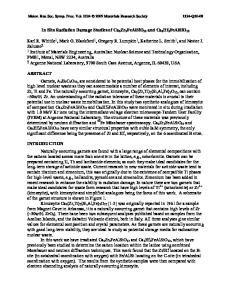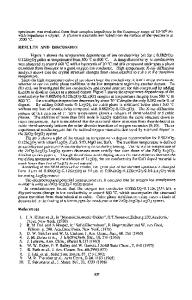A Comparative Study of Radiation Damage In A1 2 O 3 , FeTiO 3 , And MgTiO 3
- PDF / 353,242 Bytes
- 6 Pages / 414.72 x 648 pts Page_size
- 32 Downloads / 357 Views
ABSTRACT Oriented single crystals of synthetic alpha-alumina (cc-A1 20 3), geikielite (MgTiO 3), and natural ilmenite (FeTiO 3) were irradiated with 200 keV argon ions under cryogenic conditions (100 K) to assess their damage response. Using Rutherford backscattering spectrometry combined with ion channeling techniques, it was found that ilmenite amorphized readily at doses below 5x 1014 alumina amorphized at a dose of 1-2x 1015 , and geikielite was amorphized at -2x 1015 Ar cm . The radiation damage response of the ilmenite crystal may be complicated by the presence of hematite exsolution lamellae and the experimentally induced oxidation of iron. The relative radiationresistance of geikielite holds promise for similar behavior in other Mg-Ti oxides. INTRODUCTION It has been known for over a decade that spinel (MgA120 4) is a very radiation resistant material, more so than any ceramic yet studied [1-4]. Recently, several criteria that may contribute to this behavior were proposed [5]: complexity of composition and the tendency for cation disorder. In a search for new radiation-resistant materials and to test this hypothesis, we recently began the first study of radiation damage response in ilmenite-group minerals (rhombohedral, R-3) using Rutherford backscattering spectrometry in conjunction with ion channeling techniques (RBS/C). In addition, we also have undertaken a similar investigation of alpha-alumina ((x-A1 20 3), which has virtually the same crystal structure (R-3c) as the ilmenite-group minerals but a simpler composition. Previous studies have demonstrated that (x-A120 3 is not easily amorphized by ion beam irradiation at room temperature [6-8]. The ilmenite-group minerals form a complete solid solution series of the composition ATiO3, with A representing Fe (ilmenite), Mg (geikielite), Mn (pyrophanite), or Zn (ecandrewsite). There is also complete solubility of ilmenite and hematite (Fe20 3; R-3c) at high temperatures (>-5001000 K, depending on bulk composition) due to disordering of Fe and Ti in ilmenite. A slowly cooling crystal of a composition intermediate between ilmenite and hematite reaches a solvus, resulting in the unmixing of the two phases. Ilmenite is very common in nature and is an important mineral for use in determining the temperature and oxygen fugacity at which igneous and metamorphic rocks crystallized. Ilmenite also can make up a significant portion of the magnetic component of a rock and is therefore also useful in paleomagnetic studies. Geikielite, pyrophanite, and ecandrewsite are considerably more rare and are only found naturally in very specific g.ological environments.
173
Mat. Res. Soc. Symp. Proc. Vol. 396 ©1996 Materials Research Society
Our study has focused on single crystals of natural ilmenite (FeTiO 3) and synthetic geikielite (MgTiO 3) and alpha-alumina (a-A120 3). The ilmenite-group minerals were chosen due to their complexity of composition compared to other oxides studied for radiation resistance and, in the case of ilmenite, its tendency for high-temperature cat
Data Loading...











